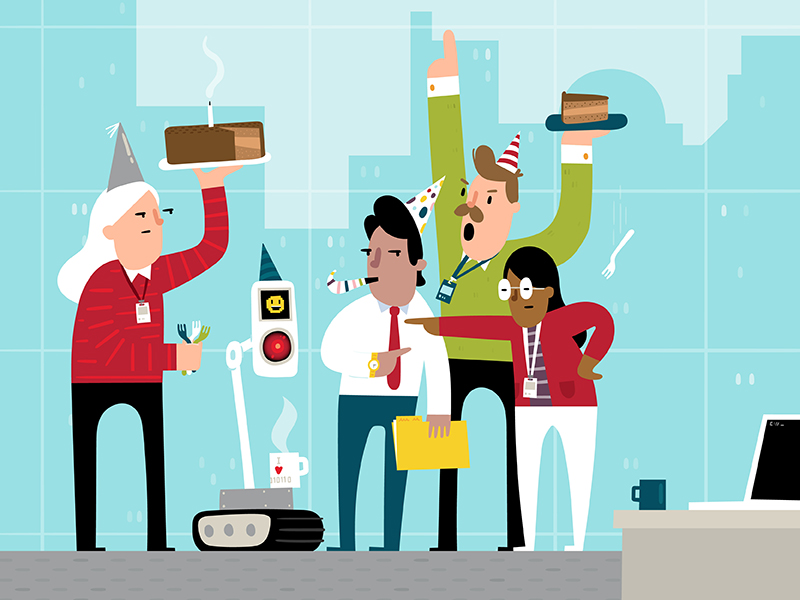Takeaways
- The introduction of AI systems into a workspace can have wide-ranging effects on employees, from increased feelings of job insecurity to higher levels of burnout.
- Terry College researchers found that more detail-oriented and conscientious employees reported the most adverse reactions to working with AI tools.
- Workers who possess a strong sense of identity outside the workplace or an openness to new experiences tend to work better with AI systems.
Whether it’s a machine learning system boosting SEO, an algorithm sorting résumés or a chatbot handling customer service, artificial intelligence already plays a role in today’s offices.
But what separates the bot seen as a busy-work savior from one viewed as a job stealer? And where’s the line between using a new tool to become more efficient and relying on it in lieu of good judgment?
While ChatGPT and DALL-E 2 made headlines in early 2023, Terry College of Business researchers spent more than a decade investigating how to best integrate machine learning systems into the workplace. Pok Man Tang, an assistant professor of management, built his academic career on investigating how employees react to AI.
Before pursuing his doctoral degree, Tang worked in investment banking and became curious about the way his co-workers talked about and to systems that helped them analyze investments.
“My colleagues were super detail-oriented, super organized, super driven, yet they all seemed to have problems working with AI,” Tang says. “They were constantly confused by AI and sometimes even yelled at the AI software. They’d complain to me and say, ‘AI is not getting along with me.’”
In a recent paper published in the Journal of Applied Psychology, Tang found the introduction of engineering robots in a manufacturing setting fueled job insecurity fears and fed antisocial behavior among employees. They experienced more burnout and were more prone to snapping at one another when upset.
In a connected experiment, survey participants asked to read articles about advancements in robot technologies were significantly more worried about job security than they were previously — even if the articles were in fields they did not work in.
This correlation even held up when looking at mere proximity. Tang found people living in areas with lots of robots working in local industries were more worried about their jobs in general.
“Whether it’s psychological or physical exposure to robots, we see the same effect consistently,” Tang says. “It predicts feelings of job insecurity that will have some unintended consequences, like burnout, impaired well-being or unethical behavior toward co-workers.”
At a bare minimum, managers must be able to forecast these types of reactions and have a plan to support employees who feel threatened by AI systems. However, other research by Tang showed managers may also need to reassess how they build teams and reward employees for their work.
In a Human Resource Management study in 2022, Tang found employees confident in their identity and value suffered more pronounced losses of self-esteem when they began to rely on AI systems to help complete their work. That confidence shift eventually led to poorer workplace performance.
Another study, published in the Academy of Management Journal, showed that the more conscientious and detail-oriented an employee was, the poorer they reacted to AI implementation. They were more likely to suffer burnout and their work performance suffered.
Tang says part of the problem is detail-oriented employees and AI are good at the same types of tasks. When the systems are introduced, it makes workers feel their role is diminished.
“Older technologies were programmable,” Tang explains. “They ran the commands or instructions given by their users. But AI is different. These systems can learn from external data to make decisions autonomously. Conscientious people also want to keep order and set the rules, so they’re set up for a clash.”
Organizational psychologists long held conscientiousness as a key trait of successful employees, Tang says. That doesn’t seem to hold true for a growing number of jobs that rely on AI.
What sets people up for success when working with AI are traits such as openness to new experiences and a strong sense of self outside the workplace. In one experiment, Tang had workers rank a list of values such as family connections and humor and write a few sentences about why each was important. That pause to value what was human showed a significant improvement in subjects’ self-esteem.
Other interventions being tested include equipping AI systems with more human characteristics. And businesses are leaning toward building personal connections between employees or finding ways to develop meaning outside of work.
In his book The Transformation Myth, Terry College management information systems professor Jerry Kane explores how businesses successfully leverage new technologies. Kane advocates for organizing cross-functional teams so people with different strengths and roles can help alleviate some of the competitive feelings toward the AI system.
Most importantly, Kane says, AI and machine learning systems should be designed to give employees more agency and autonomy of thought.
“AI is a new technology and a new set of tools,” he says. “But people are still the same. Organizations are the same. It’s going take time to integrate them into our workflows and the ways we work in the office.”

